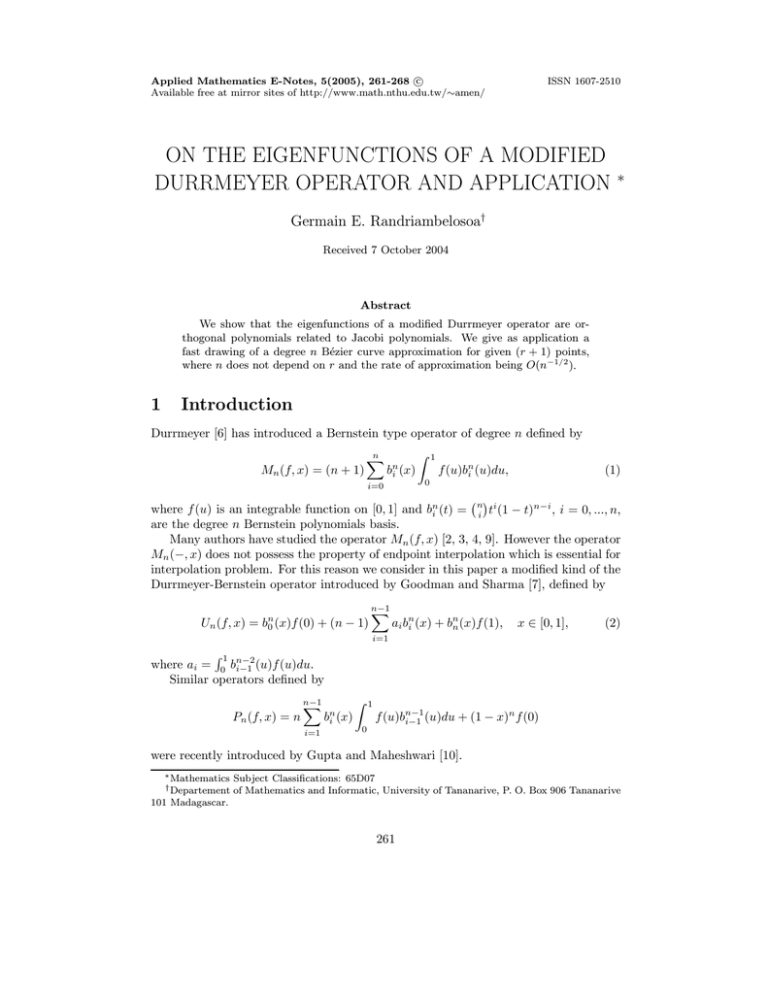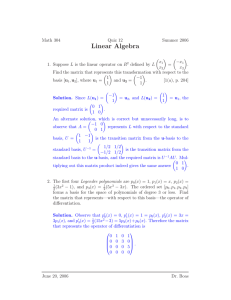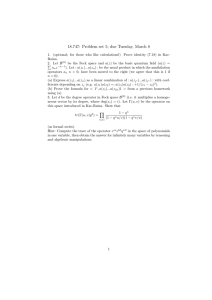Document 10677261
advertisement

Applied Mathematics E-Notes, 5(2005), 261-268 c Available free at mirror sites of http://www.math.nthu.edu.tw/∼amen/ ISSN 1607-2510 ON THE EIGENFUNCTIONS OF A MODIFIED DURRMEYER OPERATOR AND APPLICATION ∗ Germain E. Randriambelosoa† Received 7 October 2004 Abstract We show that the eigenfunctions of a modified Durrmeyer operator are orthogonal polynomials related to Jacobi polynomials. We give as application a fast drawing of a degree n Bézier curve approximation for given (r + 1) points, where n does not depend on r and the rate of approximation being O(n−1/2 ). 1 Introduction Durrmeyer [6] has introduced a Bernstein type operator of degree n defined by Mn (f, x) = (n + 1) n [ bni (x) ] 1 f (u)bni (u)du, (1) 0 i=0 where f (u) is an integrable function on [0, 1] and bni (t) = ni ti (1 − t)n−i , i = 0, ..., n, are the degree n Bernstein polynomials basis. Many authors have studied the operator Mn (f, x) [2, 3, 4, 9]. However the operator Mn (−, x) does not possess the property of endpoint interpolation which is essential for interpolation problem. For this reason we consider in this paper a modified kind of the Durrmeyer-Bernstein operator introduced by Goodman and Sharma [7], defined by Un (f, x) = bn0 (x)f (0) + (n − 1) U1 where ai = 0 bn−2 i−1 (u)f (u)du. Similar operators defined by Pn (f, x) = n n−1 [ i=1 bni (x) ] 0 n−1 [ ai bni (x) + bnn (x)f (1), i=1 x ∈ [0, 1], (2) 1 n f (u)bn−1 i−1 (u)du + (1 − x) f (0) were recently introduced by Gupta and Maheshwari [10]. ∗ Mathematics † Departement Subject Classifications: 65D07 of Mathematics and Informatic, University of Tananarive, P. O. Box 906 Tananarive 101 Madagascar. 261 262 Eigenfunctions of a Modified Durrmeyer Operator The operator Un (f, x) satisfies the endpoint conditions Un (f, 0) = f (0), Un (f, 1) = f (1), and have interesting properties [7]. In particular, Un (−, x) is a linear positive operator such that Un (1, x) = 1, and U n(f ) − f ∞ = f ∞ , where f ∞ = supt∈[0,1] |f (t)|. In section 2 we establish a common property [2] shared by Mn and Un by giving the expression of Un (tk , x) in terms of the Bernstein basis bpi (x), i = 0, ..., p with p = min(n, k). Then we show that the eigenfunctions of the operator Un are orthogonal polynomials. In section 3 we present a degree n approximation of a set of (r + 1) given points q0 , q1 , ..., qr in Rd where n does not depend on r. More precisely we approximate the polygonal line passing through the given points qi by a Bézier curve using the operator Un (f, t) expressed in term of the Sneigenfunctions. This method yields a fast drawing of the Bézier curve Un (f, t) = i=0 pi bni (t) with only O(n) multiplications while the usual de Casteljau algorithm [6] using a repeated linear interpolation of the control points pi , i = 0, ..., n needs O(n2 ) multiplications. 2 Some Basic Properties We give below useful basic properties of the operator Un . In particular, • If f (t) is a degree k polynomial with k ≤ n then Un (f, x) is a degree k polynomial. • The eigenfunctions of Un are orthogonal polynomials. Goodman and Sharma [7] have given the expression of Un (tk , x) in terms of the monomial basis (1, x, · · · , xk ). We shall show that in fact Un (tk , x) is of degree p = min(n, k) and it can be given in terms of the Bernstein basis bpi (x). This property is also shared by Mn and plays an important role in the next section. PROPOSITION 1. (i). For all integers n ≥ 1, k ≥ 1, let p = min(n, k) and q = max(n, k). Then n k [ [ k+i n n+i k bi (t) = bi (t), k n i=0 i=0 n k [ [ k+i−1 n n+i−1 k k bi (t) = n bi (t). k n i=0 i=0 (3) (4) (ii). Un (tk , x) is a polynomial of degree p such that p Un (tk , x) = with αi = q q+i−1 . q (n − 1)!(k − 1)! [ αi bpi (x), (n + k − 1)! i=0 (5) G. E. Randriambelosoa 263 PROOF. (i). If n = k the identity (3) is obvious. Assume that n > k and let 1 k un,k (x, y) = k! x (x + y)n , then we have n n 1 ∂ k [ n k+i n−i [ n k + i i n−i ∂k un,k (x, y) = = x y xy i k ∂xk k! ∂xk i=0 i i=0 k k 1 ∂ n [ k n+i k−i [ k n + i i k−i ∂n u (x, y) = y = x xy . k,n i k ∂xn n! ∂xn i=0 i i=0 For y = 1 − x, the above equations give n [ ∂k k+i n un,k (x, y) = bi (x), ∂xk k i=0 k [ n+i k ∂n u (x, y) = bi (x). k,n n ∂xn i=0 (6) (7) On the other hand using Liebnitz formula for derivative we obtain k k [ ∂k k n i 1 [ k ∂ k−i k ∂ i n u (x, y) = x (x + y) = x (x + y)n−i , n,k i i ∂xk k! i=0 i ∂xk−i ∂xi i=0 n ∂n 1 [ n ∂ n−i n ∂ i u (x, y) = x (x + y)k . k,n ∂xn n! i=0 i ∂xn−i ∂xi The assumption n > k implies that ∂i ∂xi (x (8) + y)k = 0 for i = k + 1, ..., n. Then k [ k n i ∂n u (x, y) = x (x + y)k−i . k,n i i ∂xn i=0 (9) Setting y = 1 − x, (8) is equal to (9), therefore (6) is equal to (7) and we get (3). Now using (3) and the degree elevation identity [6] (x) = (i + 1)bki+1 (x) + (k − i)bki (x), kbk−1 i we have n n n [ [ [ k+i−1 n k+i n k+i−1 n bi (x) = bi (x) − bi (x) k k k−1 i=0 i=0 i=0 k k−1 [ [ n + i n+i k = (x) bi (x) − bk−1 i n n i=0 i=0 k [ n+i n+i−1 i n+i k−i k = − − bi (x) n n k n k i=0 k n [ n+i−1 k = bi (x). n k i=0 264 Eigenfunctions of a Modified Durrmeyer Operator The proof of part 1 is complete. For instance we have the following remarkable results: S • for k = 1 and n ≥ 1, ni=0 ibni (x) = nx, S • for k = 2 and n ≥ 2, ni=0 i(i + 1)bni (x) = nb21 (x) + n(n + 1)b2 (x). (ii). By the definition (2) of the operator Un , we have n−1 [ Un (tk , x) = (n − 1) bni (x) i=1 We can write tk bn−2 i−1 (t) ] 0 1 n tk bn−2 i−1 (t)dt + bn (x). n−2 i−1 = n+k−2 bn+k−2 k+i−1 (t), k+i−1 and using the well known result [6] Un (tk , x) = = U1 0 bni (t)dt = 1/(n + 1), we obtain n−1 (n − 1)!(k − 1)! [ k + i − 1 n k bi (x) + bnn (x) k (n + k − 1)! i=1 n (n − 1)!(k − 1)! [ k + i − 1 n k bi (x). k (n + k − 1)! i=0 From the identity (4), we get n (n − 1)!(k − 1)! [ q + i − 1 p q bi (x), Un (t , x) = q (n + k − 1)! i=0 k and q+i−1 αi = q , q with q = max(n, k) and p = min(n, k). The proof is complete. We consider the Hilbert space L2 [0, 1] with the inner product ] 1 f, g (α,β) = f (t)g(t)ω(α,β) (t)dt, 0 α β where ω(α,β) (t) = t (1 − t) . from [7, Theorem 4], the operator Un has eigenvalues λn,m = (n − 1)!n! , m = 0, 1, ..., n, (n − 1 + m)!(n − m)! and for m ≥ 2 corresponding eigenfunctions Fm−2 (x) where Fm (x) = dm m+1 x (1 − x)m+1 . dxm (10) G. E. Randriambelosoa 265 Since λn,0 = λn,1 = 1, we see by (2) and (5) that the corresponding eigenfunctions are 1 and x. Notice that the eigenfunctions Fm (x) do not depend on n. PROPOSITION 2. (i) The eigenfunctions Fm (x) are orthogonal polynomials in L2 [0, 1] with respect to the inner product f, g (−1,−1) and we have ] 1 fm (t)fj (t)ω(−1,−1) (t)dt = cm δmj , 0 where δmj is the Kronecker symbol and cm = (m!)2 (m + 1)/(2m + 3)(m + 2). (ii) The following recursion formula holds: (n + 1)(n + 3)Fn+1 (x) = (2n + 3)(n + 2)xFn (x) − (n + 1)(n + 2)Fn−1 (x). (11) PROOF. (i). On the interval [0, 1] Jacobi polynomials of equal parameters α = β can be defined by the Rodrigues formula [1] (upto a constant factor). Pna (x) = (x − x2 )−α dn (x − x2 )n+α , dxn x ∈ [0, 1], (12) and the polynomials Pn (x) are orthogonal in L2 [0, 1] with respect to the inner product f, g (α,α) . From (12) we obtain Fn (x) = x(1 − x)Pn1 (x). (13) 1 Then, x(1 − x)Pn1 (x)Pm (x) = x−1 (1 − x)−1 Fn (x)Fm (x), which gives Pn (x), Pm (x) (1,1) = Fn (x), Fm (x) (−1,−1) = 0, m = n. For m = n, a repeated integration by parts yields Fm 2L2 [0,1] = cm . (ii). Jacobi orthogonal polynomials Pn1 satisfy the three-term recursion formula 1 1 (x) = (2n + 3)(n + 2)xPn1 (x) − (n + 1)(n + 2)Pn−1 (x). (n + 1)(n + 3)Pn+1 (14) From (13) and (14) we obtain the recursion formula (11). PROPOSITION 3. (i). Let G0 = f ∈ L1 [0, 1] : f (0) = f (1) = 0 . Then for f, g ∈ G0 , we have Un (f ), g (−1,−1) = f, Un (g) (−1,−1) , i.e. the operator Un is self adjoint in G0 and λn,m = 0, m > n. (ii). For any f ∈ G0 , the operator Un can be expressed in term of Fm (x) as Un (f, x) = n [ λn,m+2 an,m (f )Fm (x), m=0 where an,m (f ) are the Fourier coefficients of f given by an,m (f ) = 1 f, Fm cm (−1,−1) . (15) 266 Eigenfunctions of a Modified Durrmeyer Operator PROOF. (i). Let f, g ∈ G0 . Then ] 1 #n−1 ] [ Un (f ), g (−1,−1) = (n − 1) bni (x)(x) 0 On the other hand we have bni (x)ω(−1,−1) (x) = Un (f ), g (−1,−1) = (n − 1) = 1 0 f, Un (g) bn−2 i−1 (t)f (t)dt 0 i=1 ] $ 1 #n−1 [ bni (x)(x) ] hence $ 1 0 i=1 (−1,−1) (n−1)n n−2 i(n−i) bi−1 , g(x)ω(−1,−1) (x)dx. bn−2 i−1 (t)g(t)dt f (x)ω(−1,−1) (x)dx . Furthermore we have λn,m = 0 if m > n. Indeed if r ≤ n and m > n we have Un (Fm ), Fr (−1,−1) = Fm , Fr (−1,−1) λn,r = 0, now by Proposition 1, Un (Fm ) is a degree n polynomial orthogonal to all polynomials of degree ≤ n, then Un (Fm ) = 0 and λn,m = 0, m > n. (ii). For integrable function f on [0, 1], Un (f, x) is a polynomial of degree n. Thus there are reals αn,m (f ) for 0 ≤ m ≤ n such that Un (f, x) = n [ αn,m (f )Fm (x). m=0 For r ≤ n we have, since Un is self adjoint Un (f ), Fr (−1,−1) = n [ αn,m (f ) Fm , Fr (−,−1) = cr αn,r (f ) m=0 = f, Un (Fr ) (−1,−1) = λn,r+2 f, Fr (−1,−1) , thus αn,r (f ) = 1 λn,r+2 f, Fr cr (−1,−1) . and the proof is complete. 3 Application The expression (15) of Un (f, x) is suitable for computation, we shall use this expression for the approximation of given points q0 , ..., qr in the affine space Rd by the Bézier curve Un (f, x). We can always assume that q0 = qr = 0. Let 0 = t0 < t1 < · · · < tr−1 < tr = 1 be a subdivision of the interval [0, 1] and f the piecewise affine function such that f (ti ) = qi , i = 0, ..., r, defined on [0, 1] by f (u) = ((ti+1−ti )qi + (u − ti )qi+1 )/(ti+1 − ti ), u ∈ [ti , ti+1 ]. G. E. Randriambelosoa 267 PROPOSITION 4. Let d be a distance in Rd associated with a norm denoted · . (i). For any integer n, one has the estimate for i = 1, ..., r, d(Un (f, ti ), qi ) = 2∆n−1/2 (16) where ∆ = max0≤h≤r ∆h and ∆h = (qh+1 − qh )/(th+1 − th ). Sn λ (ii). Let Ak = f, Fk (−1,−1) . Then Un (f, x) = k=0 n,k+2 ck Ak Fk (x) with r−1 Ak = [ −1 Fk (ti )∆2i , (k + 2)(k + 1) i=1 k = 0, ..., r, (17) where ∆2i = ∆i − ∆i−1 . PROOF. (i). Inequality (16) is a consequence of the next estimation given by [7, Theorem 11] Un (f ) − fk = 2ω(f ; n−1/2 ), where ω(f ; h) = sup(x,t)∈H |f (x + t) − f (x)|, H = (x, t), /|t| = h, (x + t, x) ∈ [0, 1]2 , is the moduli of continuity of f . (ii). It is known [7] that Fm (x) satisfies the differential equation x(1 − x)yxx + (m + 2)(m + 1)y = 0, and it follows immediately that Ak = ek = ek ] 1 f (u)Fk (u)du = ek 0 # r−1 ] [ i=0 ti+1 f (u)F k(u)du ti qr Fm (1) − q0 Fm (0) − ∆r−1 Fm (1) + ∆0 Fm (0) + r−1 [ i=1 Fm (ti )∆2i $ , −1 . Since q0 = qr = 0 and Fm (1) = Fm (0) = 0, we obtain (17). with ek = (k+2)(k+1) The three-term recursion formula (11) provides an efficient and fast algorithm for computing the values of Un (f ) expressed in term of the polynomials Fm (x) with only O(n) multiplications while the de Casteljau algorithm [6] related to Bernstein basis polynomials needs O(n2 ) multiplications. Acknowledgment. The author would like to acknowledge the suggestions and recommendations of an anonymous referee who has contributed to improve the final version of the paper. References [1] M. Abramowitz and I. A. Stegun (Eds.), Orthogonal Polynomials, Ch. 22 in Handbook of Mathematical Functions with Formulas, Graphs, and Mathematical Tables, 9-th printing. New York: Dover, (1972), 771—802. 268 Eigenfunctions of a Modified Durrmeyer Operator [2] P. N. Agrawal and V. Gupta, Simultaneous approximation by linear combination of modified Bernstein polynomials, Bull Greek Math. Soc. 39 (1989), 29—43. [3] M. M. Derriennic, Sur l’approximation de fonctions intégrables sur [0, 1] par des polynômes de Bernstein modifiés, J. Approx. Theory, 31(4)(1981), 325—343 (in French). [4] Z. Ditzian and K. Ivanov, Bernstein type operators and their derivatives, J. Approx. Theory 56(1989), 72-90. [5] J. L. Durrmeyer, Une formule d’inversion de la transforméee de Laplace Applications a la théorie des moments, Thése de 3e cycle, Faculté des Sciences de Paris, (1967). [6] G. Farin, Curves and Surfaces for Computer Aided Geometric Design, Academic Press, New York, 1988. [7] T. N. T. Goodman and A. Sharma, A Bernstein type operator on the simplex, Math. Balkanica (N.S.), 5(1991), 129—145 [8] G. Szegö, Orthogonal Polynomials, A. M. S. Colloquim Series, Vol 23, Revised edition, 1959. [9] V. Gupta, A note on modified Bernstein polynomials, Pure and Applied Math Sci. 44(1-2)(1996), 1—3. [10] V. Gupta and P. Maheshwari, Bezier variant of a new Durrmeyer type operators. Riv. Mat. Univ. Parma (7) 2 (2003), 9—21.






